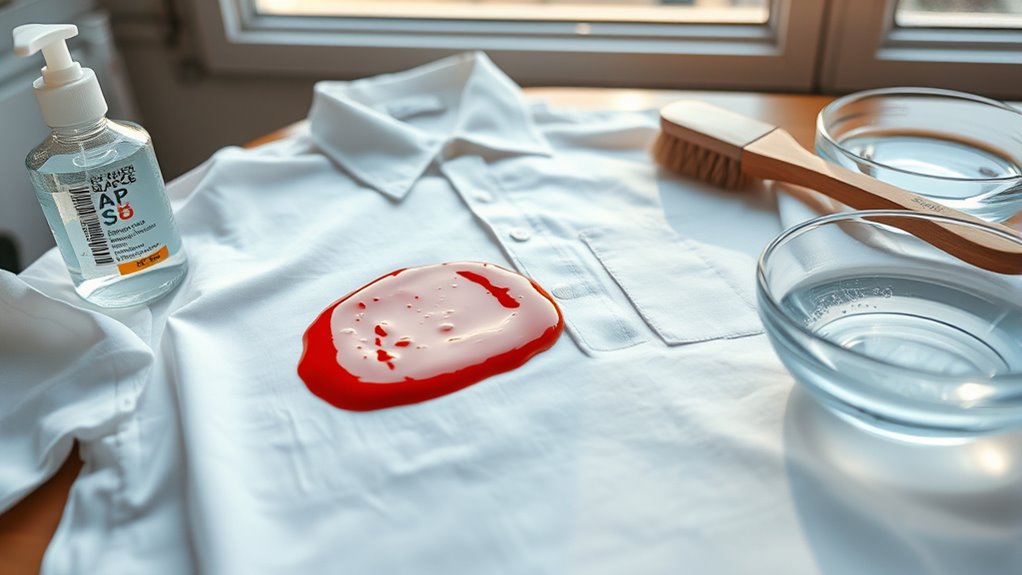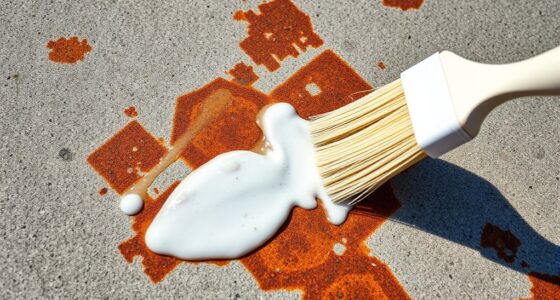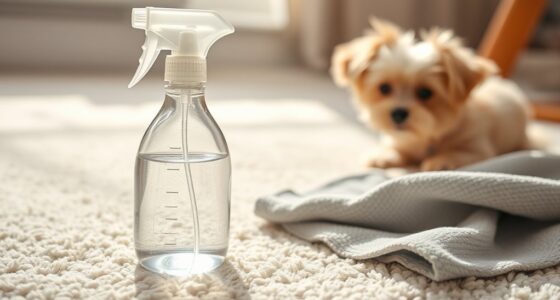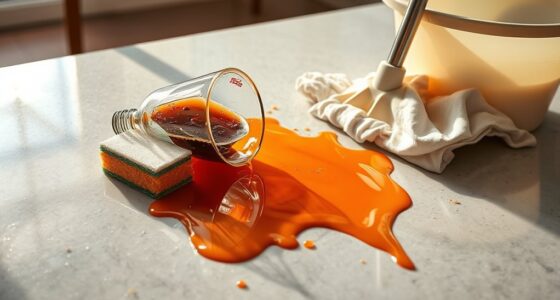To remove tomato sauce stains from clothing, act fast! Gently scrape away excess sauce and blot the area with paper towels. Rinse the stain under cold water from the back. Apply liquid dish soap or heavy-duty detergent; rub it in gently. For tougher stains, try a paste of baking soda and salt or use white vinegar. Rinse thoroughly and wash according to fabric care guidelines. There are more tips and techniques that can help tackle stubborn stains effectively.
Key Takeaways
- Gently scrape off excess sauce and blot the stain with paper towels to absorb as much as possible.
- Rinse the stained area with cold water from the reverse side to prevent the stain from spreading.
- Apply liquid dish soap or heavy-duty laundry detergent, rubbing it gently into the stain in a circular motion.
- Soak the fabric in cold water with baking soda or white vinegar for enhanced stain removal and agitation.
- After treatment, wash the item according to care instructions and air-dry to avoid setting any remaining stains.
Understanding Tomato Sauce Stains
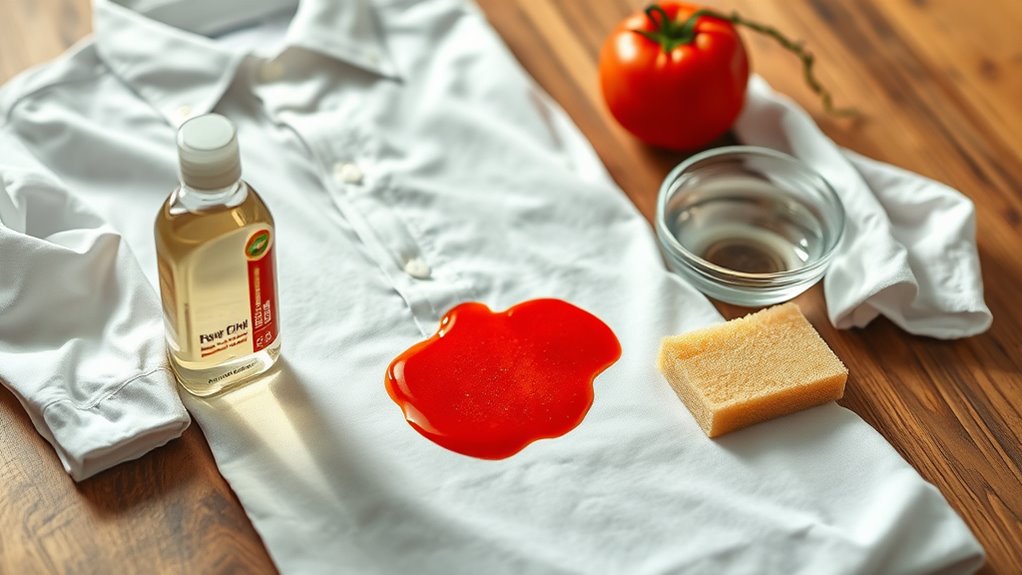
When you spill tomato sauce, understanding the nature of the stain can make a big difference in how effectively you can remove it.
Tomato sauce contains pigments like lycopene, tannins, oils, and proteins, all contributing to its staining power. Lycopene gives that vibrant red color, while the natural acidity of the sauce breaks down fabric fibers on contact, setting the stain quickly. The initial stain treatment is crucial for successfully lifting the stain before it sets. The oils create a barrier that clings to the fibers, making removal tougher. Additionally, environmental factors like humidity and temperature can accelerate stain setting.
Since tomato stains are hybrid, combining elements of oil, tannin, and protein, they require a tailored approach for effective cleaning. Knowing these details helps you tackle the stain head-on.
Immediate Actions to Take

To effectively tackle a tomato sauce stain, it’s crucial to act swiftly and follow a few key steps.
First, use a spoon or knife to gently scrape away any excess sauce without rubbing, which can push the stain deeper. Blot the area with paper towels to absorb more sauce.
Next, hold the stained area under cold running water for a few minutes, rinsing from the reverse side to help force the stain out. Avoid hot water, as it can set the stain. Remember, acting quickly is essential as the acidity of tomatoes can set stains into fabric.
Finally, apply a small amount of liquid dish soap or heavy-duty laundry detergent, rubbing it gently in a circular motion. Let it sit for about 10 minutes before rinsing thoroughly.
Immediate action increases your chances of successful removal.
Choosing the Right Detergent
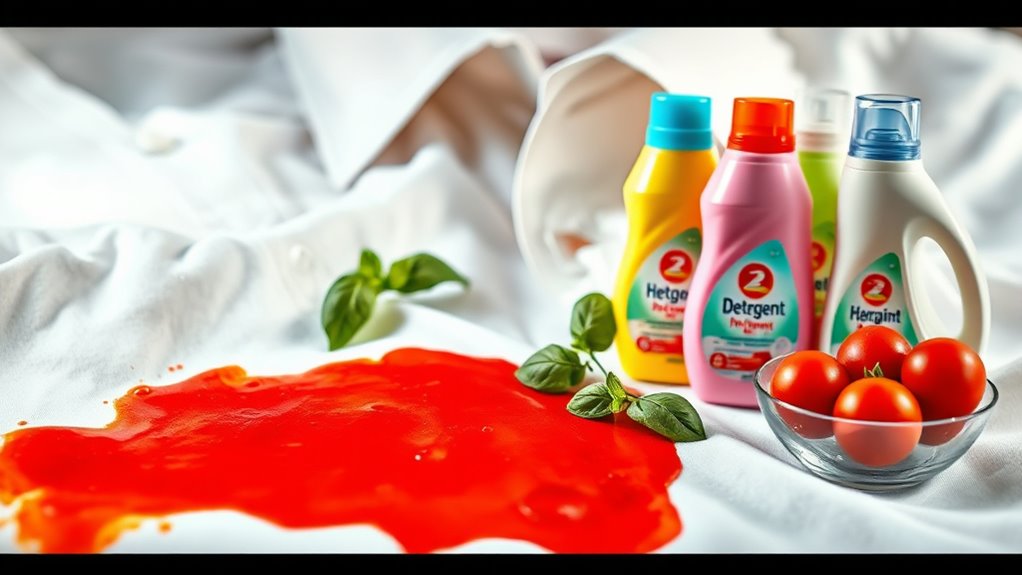
After taking immediate action to treat the tomato sauce stain, selecting the right detergent is key to achieving the best results.
Opt for enzymatic detergents, as they break down the proteins in the sauce effectively. Heavy-duty detergents are also great for tackling stubborn stains. If you prefer a more gentle approach, dish soap can help dissolve oils found in tomato sauce.
For tough tannin-based stains, specialized stain removers like hydrogen peroxide work wonders. If you’re using laundry pods, choose ones with enhanced cleaning power, like Tide OXI Boost PODS. Immediate action is crucial for best results, so make sure to treat the stains promptly to increase the effectiveness of your detergent.
Always make certain your detergent is compatible with your fabric type and safe for colors, so you don’t risk damaging your clothes while removing those pesky stains.
Effective Household Remedies
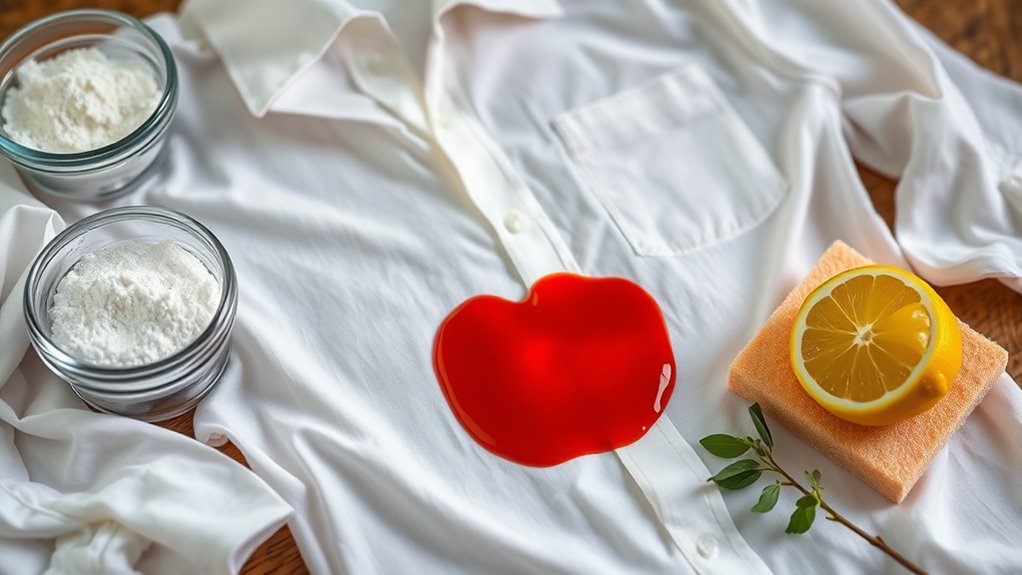
If you find yourself with a stubborn tomato sauce stain, effective household remedies can make a significant difference in removing it. Start by flushing the stain with cold water from the back to prevent spreading. Gently scrape off excess sauce with a spoon, then apply a bit of dish soap and rub it in. For tougher stains, create a paste with baking soda and salt, or blot with white vinegar. You can also try hydrogen peroxide or lemon juice for their stain-fighting properties. If you prefer a scrub, use a baking soda paste. Finally, enzyme-based stain removers work wonders on protein stains, as they utilize specific cleaning solutions to break down the stain effectively. Always act quickly, and remember to avoid heat until you confirm the stain’s gone!
Special Considerations for Different Fabrics
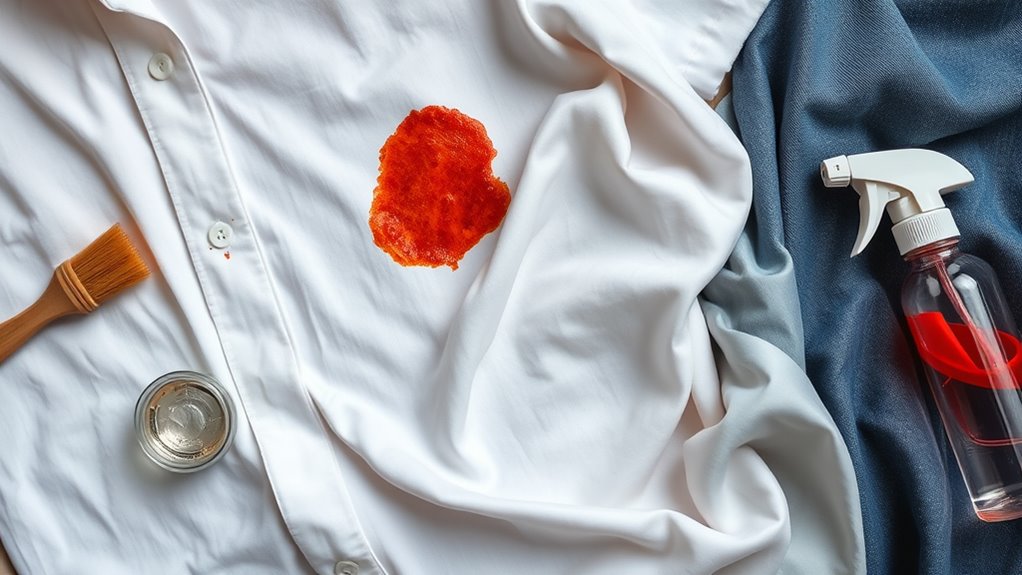
When dealing with tomato sauce stains, understanding the unique needs of various fabrics is essential for effective removal.
For delicate fabrics, always check the care label to avoid damage. Cotton and linen respond well to pre-treatment with dish soap or liquid laundry detergent. If you’re working with silk or wool, use mild cleaning agents and hand washing techniques to protect the fibers. For synthetic fibers like polyester and nylon, stick to cold water to prevent deterioration. Blended fabrics require a gentle approach, combining pre-treatment with careful washing. Additionally, consider using mild, acid-free cleaners to protect sensitive materials during stain removal. Remember, avoid harsh chemicals on sensitive materials and always air dry to maintain fabric integrity.
With these strategies, you can tackle stains effectively without compromising your garments.
Soaking Techniques for Stubborn Stains
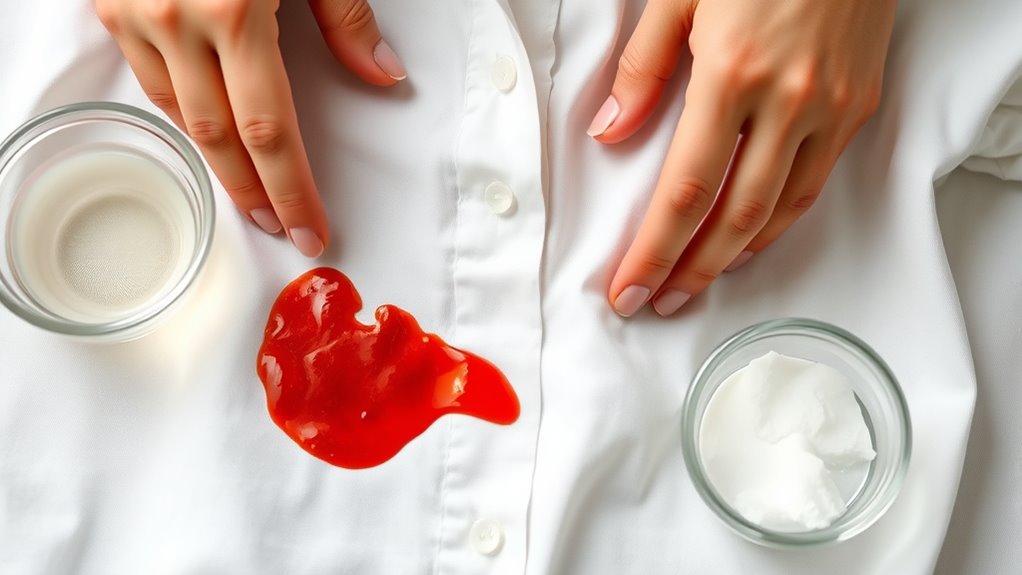
Soaking techniques play an essential role in tackling stubborn tomato sauce stains, especially since timely action can prevent the stain from becoming permanent. Start by soaking the fabric in cold water to neutralize the stain’s acidity. You can enhance the soaking process using solutions like a baking soda mix or a gentle detergent. For added effectiveness, try soaking with white vinegar for about 5-10 minutes. During soaking, gently agitate the fabric every so often to help lift the stain. Don’t forget to rinse the fabric under cold water periodically to check your progress. If the stain persists, patience is key—repeated soaking might be necessary to achieve the best results. Regularly inspect the fabric to monitor the stain’s removal. Prompt action is critical, as delaying treatment can lead to setting.
Washing Methods After Pre-Treatment
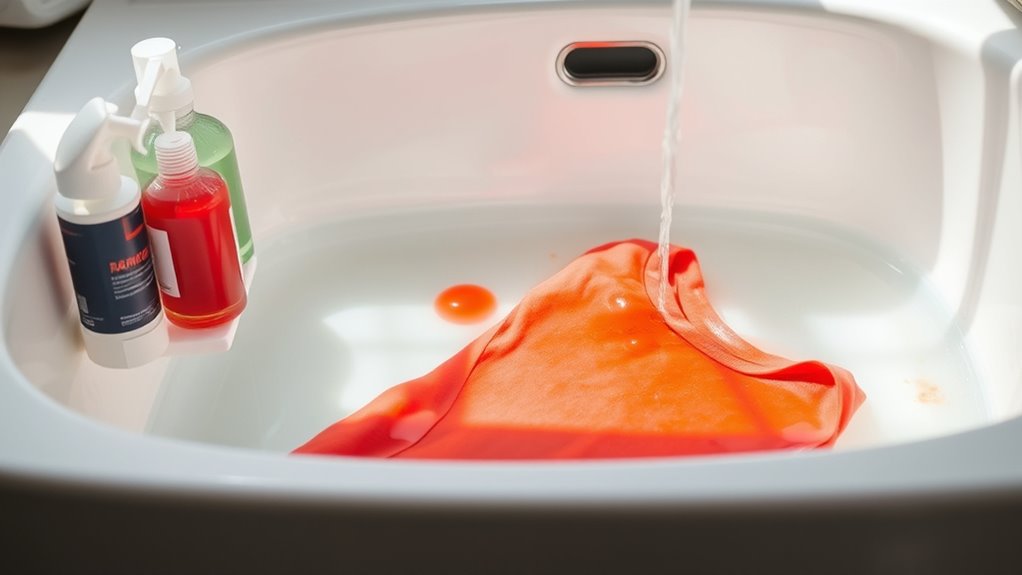
After you’ve pre-treated the tomato sauce stain, it’s crucial to follow the right washing methods to guarantee complete removal.
Always check fabric care labels for specific instructions and use cold water to prevent setting the stain. Avoid hot water, as it can make the stain permanent. Washing fabrics promptly is important, as removing excess tomato sauce can help in the overall stain removal process.
Wash your clothes as soon as possible, using a regular cycle for most fabrics. For delicate materials like silk or wool, choose a delicate cycle or hand wash if necessary.
Opt for heavy-duty, enzyme-based liquid detergents for the best results.
After washing, inspect the fabric; air-dry garments to avoid setting any remaining stains. If the stain persists, repeat the pre-treatment and washing process.
Never tumble dry until you’re sure the stain is gone.
Persistence in Stain Removal
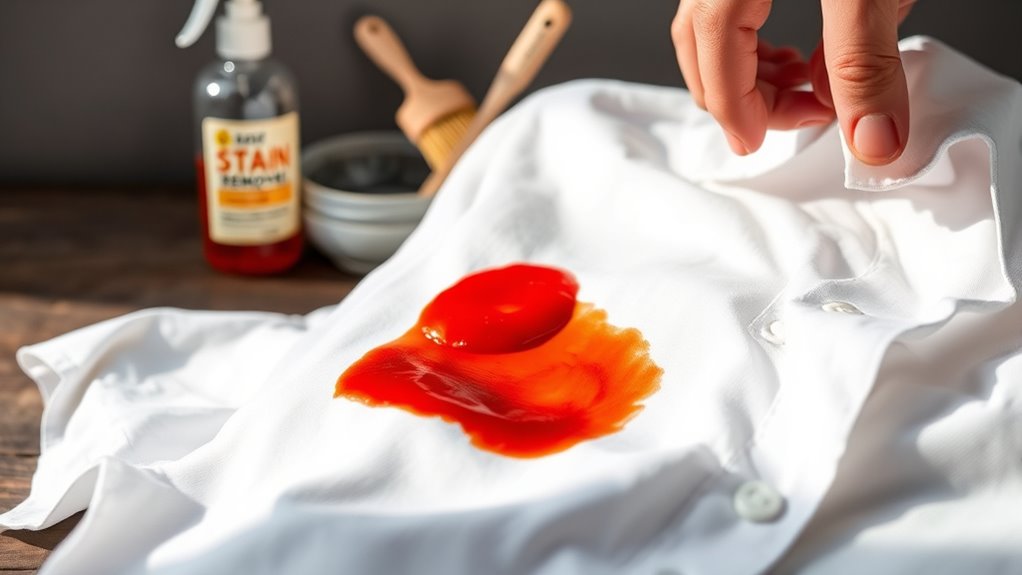
Effective stain removal often requires persistence, especially with stubborn tomato sauce stains. Start by acting quickly; rinse the stain with cold water and gently scrape off any excess sauce. Apply liquid detergent directly onto the stain and rinse thoroughly. If it lingers, don’t hesitate to repeat this process. For tougher stains, try enzyme-based treatments that target the proteins and tannins in tomato sauce. Let the product sit for at least five minutes before rinsing. If the stain persists, soak the garment in warm water, using an enzyme-based detergent overnight if needed. Remember to avoid hot water, as it can set the stain and make it more difficult to remove. Finally, always check for the stain before drying; patience is key in this process.
Tips for Future Stain Prevention
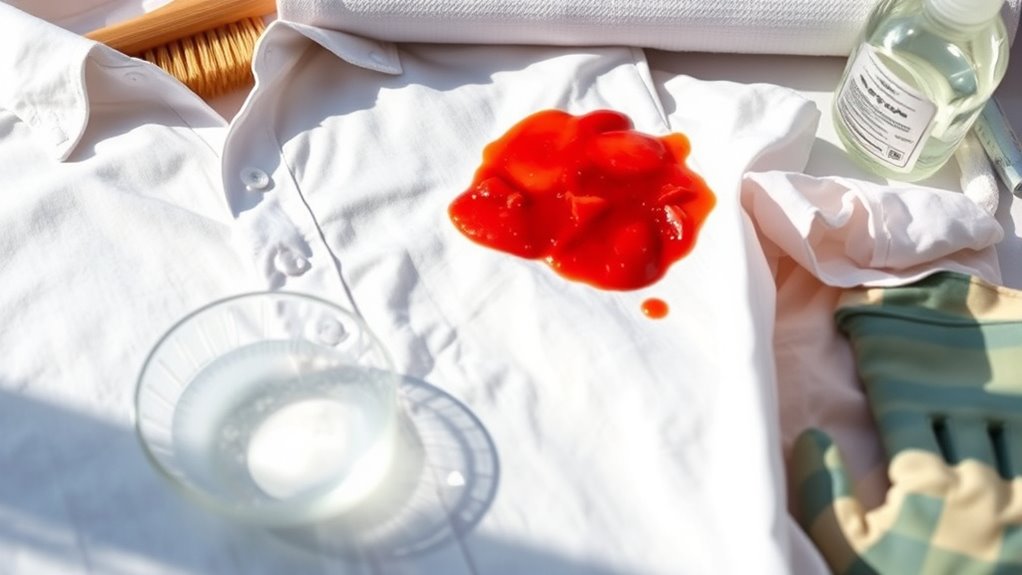
To keep tomato sauce stains at bay, it’s wise to take a few preventive measures before you even start cooking.
First, wear an apron to protect your clothes from splatters. If a spill occurs, clean it up immediately to prevent the stain from setting. Additionally, aim to remove excess sauce quickly to minimize the potential for staining.
Choose fabrics that are stain-resistant or easier to clean, as this can save you a headache later. Consider applying stain-repelling sprays on your clothing for extra protection.
After washing any stained items, air-dry them instead of using heat, which can set stains.
Finally, if you’re working with delicate fabrics, always use cold water and gentle detergents to avoid damage.
A little precaution goes a long way in keeping your clothes stain-free!
Frequently Asked Questions
Can I Use Heat to Speed up Stain Removal?
You might think using heat can speed up stain removal, but it can actually set the stain, making it tougher to remove later.
Instead, start with cold water to flush the stain out. If needed, you can soak the fabric in warm water afterward.
Just remember not to use a dryer until you’re sure the stain is gone, as the heat can lock it in, complicating your cleaning efforts.
What if the Stain Has Dried?
If the stain’s dried, don’t panic. Start by gently scraping off any residue.
Next, apply a stain remover or a vinegar solution, letting it sit for about 15 minutes.
For tougher stains, soak the fabric in a baking soda solution.
Always wash it in cold water to prevent the stain from setting further.
Are There Any Fabric Types That Are Stain-Proof?
There aren’t any truly stain-proof fabrics, but some types are highly stain-resistant.
Fabrics like polyester and olefin repel water-based stains, making clean-up easier. Microfiber’s compact weave prevents liquid absorption, while leather offers natural resistance to small spills.
However, even these fabrics require regular maintenance to keep their protective qualities.
How Can I Prevent Future Tomato Sauce Stains?
To prevent pesky pasta sauce stains, prioritize protection!
Start by selecting stain-resistant fabrics and applying fabric protectors to your clothes. When dining, designate a safe space for messy meals and always keep absorbent tissues handy for quick cleanups.
Wearing an apron while cooking helps shield your outfit, too. Remember, acting fast is key!
With these simple strategies, you’ll dodge drips and keep your clothes looking fresh and fabulous.
Is It Safe to Use Bleach on All Fabrics?
No, it’s not safe to use bleach on all fabrics. You need to check the care label first.
Fabrics like spandex or delicate materials such as silk and wool can’t handle bleach without damage.
For white cottons, chlorine bleach works well, but always dilute it.
If you’re dealing with colored fabrics, stick to color-safe bleach to avoid fading.
Testing on a hidden area first is a smart move to prevent irreversible damage.
Conclusion
When it comes to tomato sauce stains, remember that “an ounce of prevention is worth a pound of cure.” By acting quickly and using the right techniques, you can save your favorite clothes from stubborn stains. Whether you choose household remedies or specific detergents, persistence is key. Keep these tips in mind for future meals, and you’ll be ready to tackle any mess that comes your way. Happy cleaning!
